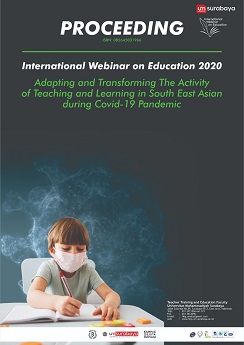Learning practice in mathematics education department of Universitas Muhammadiyah Surabaya during covid-19 pandemic
Abstract
Abstract.
The purpose of this research is to describe the practice of learning during the
covid-19 pandemic in Mathematics Educations Department at Teacher Training and
Education Faculty of Universitas Muhammadiyah Surabaya (UM Surabaya). The research used descriptive explorative methods with qualitative approach. The research subjects consisted of students and lecturers in the mathematics education department at Teacher Training and Education Faculty of UM Surabaya. Data collected by documentation, questionnaire, and interview techniques. Triangulation of sources was used to test data validity. Data from students were compared by lecturers‘ data. The data were analysed through three stages, i.e., reduction, data presentation, and drawing conclusions. The results showed that during the covid-19 pandemic, there are four alternatives learning practices implemented by lecturers. Each alternative consist of 3 stages: delivery, activity, and assessment. The online media used were Zoom, WhatsApp, YouTube, e-mail and Google Meet. The most effective online learning media according to lecturers is Zoom. Meanwhile, according to students, the most effective online media is YouTube. The obstacles faced by students and lecturers are internet network and quota. The learning practices carried out by lecturers during the covid-19 pandemic helped students to keep learning
References
S. Arsendy, G. A. Sukoco, and R. E. Purba, ―Riset dampak covid-19: potret gap akses online belajar dari rumah dari 4 provinsi,‖ 2020. [Online]. Available:
https://theconversation.com/riset-dampak-covid-19-potret-gap-akses-online-belajar-darirumah-dari-4-provinsi-136534. [Accessed: 23-May-2020].
W. A. F. Dewi, ―Dampak covid-19 terhadap implementasi pembelajaran daring di sekolah dasar,‖ Edukatif J. Ilmu Pendidik., vol. 2, no. 1, pp. 55–61, 2020.
A. J. M. Guerrero, I. A. Diaz, P. C. Reche, and S. A. Garcia, ―E-learning in the teaching ofmathematics: an educational experience in adult high school,‖Mathematics, vol. 8, no. 5,pp. 1–16, 2020.
LLDIKTI 7, ―Kebijakan pembelajaran daring perguruan tinggi pada masa pandemi covid-19.,‖ 2020. [Online]. Available:http://lldikti7.ristekdikti.go.id/pengumumanDetail.php?id=23334. [Accessed: 23-May-2020].
D. Gorska, ―E-learning in higher education,‖ Pers. challenges, vol. 6, no. 2, pp. 35–43,2016.
C. Keller and L. Cernerud, ―Students‘ perceptions of e-learning in university education,‖ J.Educ. media, vol. 27, no. 1, pp. 55–67, 2002.
M. D. G. Allo, ―Is the online learning good in the midst covid-19 pandemic? the case of EFL learners,‖ J. Sinestesia, vol. 10, no. 1, pp. 1–10, 2020.
I. Holisin, ―Profil penalaran siswa sekolah dasar dalam menyelesaikan masalah pecahan ditinjau dari perbedaan gender dan kemampuan matematika,‖ Surabaya, 2015.
D. Setiawan, ―Tren rapat jarak jauh via konferensi video,‖ Tabloid Kontan, Jakarta, pp. 10– 11, Apr-2020.
L. Sofyana and A. Rozaq, ―Pembelajaran daring kombinasi berbasis whatsapp pada kelas karyawan prodi teknik informatika Universitas PGRI Madiun,‖ J. Nas. Pendidik. Tek. Inform., vol. 8, no. 1, pp. 81–86, 2019.
M. M. L. Yeo, ―Social media and social networking applications for teaching and learning,‖ Eur. J. Sci. Math. Educ., vol. 2, no. 1, pp. 53–62, 2014






